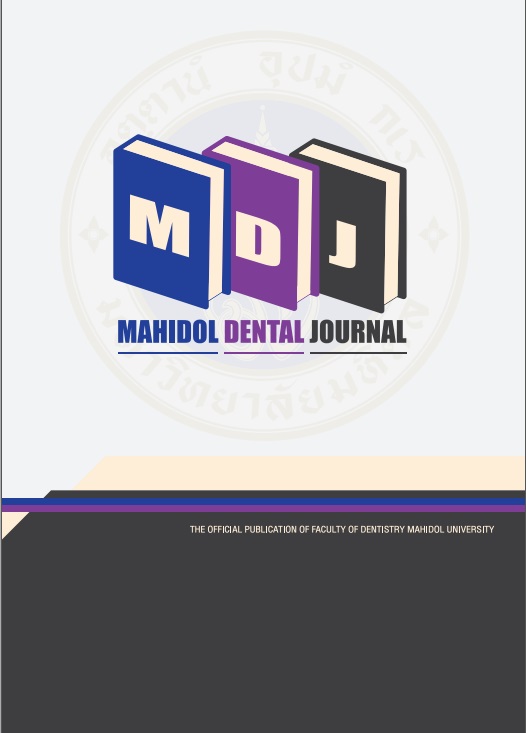Gingival squamous cell carcinoma of the anterior mandible clinically presenting as a reactive gingival growth: a case report
Main Article Content
Abstract
Objectives: The incidence of oral malignancy presenting in the gingiva is very low. Gingival squamous cell carcinoma can appear similar to a variety of gingival lesions ranging from benign reactive inflammatory lesions to less common malignancies. Misdiagnosis often leads to delayed management of the disease that affects the patient’s prognosis and survival rate. This case report describes a case of gingival squamous cell carcinoma of the mandibular incisors presenting clinically as reactive pyogenic granuloma.
Methods: A 46-year-old female was referred to the Periodontal Specialist Clinic in 2019 with a complaint of recurrent gum swelling in the lower front teeth region, which she claimed occurred after a small piece of apple got stuck between her teeth. The swelling was painless, however, she felt discomfort. Based on the clinically benign-looking lesion, a differential diagnosis of pyogenic granuloma, fibrous epulis, and other benign reactive/inflammatory lesions was made. An excisional biopsy was performed under local anaesthesia.
Results: The histological examination revealed severely dysplastic stratified squamous epithelium invading into the underlying connective tissue. The final diagnosis is a well-differentiated squamous cell carcinoma of the gingiva (T1N0M0).
Conclusions: The important role of dental practitioners in the early detection of gingival malignancy, especially for those practising in periodontal specialist settings, can significantly improve patient survival. This case report demonstrates the need to biopsy all suspicious gingival lesions for histopathological examination.
Article Details
References
Warnakulasuriya S. Global epidemiology of oral and oropharyngeal cancer. Oral Oncol 2009; 45: 309-16.
Feller L, Lemmer J. Oral squamous cell carcinoma: Epidemiology, clinical presentation and treatment. J Cancer Ther 2012; 3: 263-68.
Levi PA, Jr., Kim DM, Harsfield SL, Jacobson ER. Squamous cell carcinoma presenting as an endodontic-periodontic lesion. J Periodontol 2005; 76: 1798-804.
Albandar JM, Susin C, Hughes FJ. Manifestations of systemic diseases and conditions that affect the periodontal attachment apparatus: Case definitions and diagnostic considerations. J Clin Periodontol 2018; 45: S171-S89.
Neville BW, Damm DD, Allen CM, Chi AC. Oral & maxillofacial pathology 4th edition. Missouri: WB Saunders, Elsevier, 2016; p.374-389.
Gupta R, Debnath N, Nayak PA, Khandelwal V. Gingival squamous cell carcinoma presenting as periodontal lesion in the mandibular posterior region. BMJ Case Rep 2014; 2014: 1-4.
Lee JJ, Cheng SJ, Lin SK, Chiang CP, Yu CH, Kok SH. Gingival squamous cell carcinoma mimicking a dentoalveolar abscess: Report of a case. J Endod 2007; 33: 177-80.
Seoane J, Varela-Centelles PI, Walsh TF, Lopez-Cedrun JL, Vazquez I. Gingival squamous cell carcinoma: Diagnostic delay or rapid invasion? J Periodontol 2006; 77: 1229-33.
Lee KC, Chuang SK, Philipone EM, Peters SM. Which clinicopathologic factors affect the prognosis of gingival squamous cell carcinoma: A population analysis of 4,345 cases. J Oral Maxillofac Surg 2019; 77: 986-93.
Effiom OA, Adeyemo WL, Omitola OG, Ajayi OF, Emmanuel MM, Gbotolorun OM. Oral squamous cell carcinoma: A clinicopathologic review of 233 cases in lagos, nigeria. J Oral Maxillofac Surg 2008; 66: 1595-99.
Dahlstrom KR, Little JA, Zafereo ME, Lung M, Wei Q, Sturgis EM. Squamous cell carcinoma of the head and neck in never smoker-never drinkers: A descriptive epidemiologic study. Head Neck 2008; 30: 75-84.
Termine N, Panzarella V, Falaschini S, Russo A, Matranga D, Lo Muzio L, et al. Hpv in oral squamous cell carcinoma vs head and neck squamous cell carcinoma biopsies: A meta-analysis (1988-2007). Ann Oncol 2008; 19: 1681-90.
Amin M, Edge S, Greene F, et al., editors. AJCC cancer staging manual 8th edition. New York: Springer, 2017; p.113-21.
Woolgar JA. Histopathological prognosticators in oral and oropharyngeal squamous cell carcinoma. Oral Oncol 2006; 42: 229-39.
Haksever M, Inancli HM, Tuncel U, Kurkcuoglu SS, Uyar M, Genc O, et al. The effects of tumor size, degree of differentiation, and depth of invasion on the risk of neck node metastasis in squamous cell carcinoma of the oral cavity. Ear Nose Throat J 2012; 91: 130-35.
Omar EA. The outline of prognosis and new advances in diagnosis of oral squamous cell carcinoma (oscc): Review of the literature. J Oral Oncol 2013; 2013: 1-13.
Brandwein-Gensler M, Teixeira MS, Lewis CM, Lee B, Rolnitzky L, Hille JJ, et al. Oral squamous cell carcinoma: Histologic risk assessment, but not margin status, is strongly predictive of local disease-free and overall survival. Am J Surg Pathol 2005; 29: 167-78.
Dik EA, Ipenburg NA, Kessler PA, van Es RJJ, Willems SM. The value of histological grading of biopsy and resection specimens in early stage oral squamous cell carcinomas. J Craniomaxillofac Surg 2018; 46: 1001-06.


